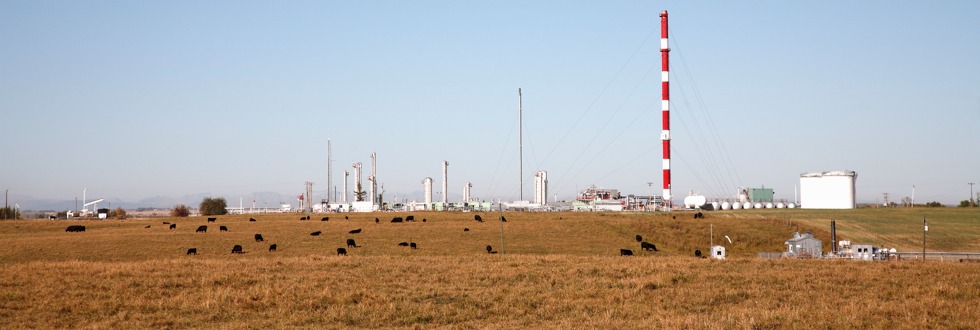Featured Projects
U.S. Department of Energy, Mission Support Alliance
Public Safety & Resource Protection – Environmental Surveillance Project
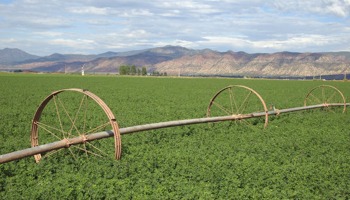
Assessing contaminant levels in agricultural products
The Hanford Site is said to have the longest continuously operating monitoring program in the United States. DOE prepared the first annual site environmental report in 1959. Today, the Public Safety and Resource Protection program’s Environmental Surveillance Project is charged with long-term monitoring of the Hanford Site and associated environs to assess potential impacts from legacy contaminants and protect human health and the environment.
Assessing Contaminant Levels. Since 2011, EAS has conducted multimedia environmental surveillance to assess contaminant levels in the Hanford environs and nearby communities. Our work continues to assist MSA prepare health and safety plans, quality assurance plans, sampling plans, and desk-top instructions for a variety of environmental media collected as part of the Surveillance Project. Our staff review analytical results and perform or oversee collection of air, surface water, sediment, soil, natural vegetation, agricultural products, and fish and wildlife to measure concentrations of radionuclides and chemicals in the environment. These include metals, anions, and volatile organic compounds.
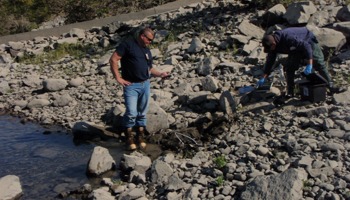
Shoreline water monitoring
Calculating Potential Radiation Doses. Another important part of EAS’s environmental surveillance work is to accurately calculate the potential radiation dose to humans, aquatic organisms, and terrestrial biota hazard quotient to evaluate risk to biota and the carcinogenic and non-carcinogenic risks to humans. EAS performs cumulative assessments of on-site and off-site environmental impacts and off-site human health exposures from Hanford Site operations. We work with MSA to share this information with tribes, regulators, and the public through the annual Hanford Site Environmental Report, which has been produced since 1959.
Monitoring Exposure Levels. EAS relies on its specialized Hanford Site expertise to monitor potential exposure pathways, including air, Columbia River water, and food and farm products, such as alfalfa, cherries, leafy vegetables, milk, potatoes, tomatoes, and wine. Working with MSA, we annually calculate radiation doses to members of the public residing within a 50-mile radius of the site. Results of these assessments help DOE determine compliance with pertinent federal regulations and human health exposure limits.

Monitoring potential exposure pathways in milk
EAS staff also support the following environmental surveillance activities:
- Annual review of the environmental surveillance program design and implementation
- Database management, data review and evaluation
- Exposure assessment and reporting.
EAS has successfully performed all contract requirements requested to date, including quality of timelines of goods and services and effective management of five subcontractors within budget constraints established by the client. MSA renewed EAS’s contract to support the PSRP program in 2014. Contract manager (Brett Tiller) holds monthly meetings with the client to review activities, budget, staff training, and any additional new scoping items that may need to be addressed. EAS provides bi-weekly cost reports in additional to monthly accrual information.
Our performance demonstrates more than 20,000 safe-worker hours and 75 boat days. No on-water safety incidents and no work-days lost have been logged even during extreme environmental conditions, including working at night and in remote areas using multiple high-risk sampling techniques such as boating, electrofishing, and SCUBA/snorkeling.
The Department of Energy’s Public Safety & Resource Protection Program has publically released Hanford Site environmental monitoring reports for more than 59 years. The most recent reports can be found at http://msa.hanford.gov/page.cfm/EnviroReports
U.S. Department of Defense, URS
Umatilla Chemical Agent Disposal Facility, Comprehensive Monitoring Program
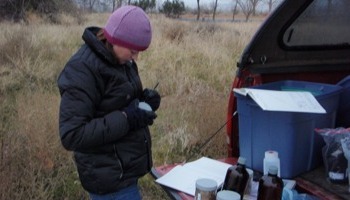
Sampling vegetation
In eastern Oregon, the Department of Defense stored chemical weapons at the Umatilla Chemical Depot (UMCD) for 40 years. The U.S. Army destroyed the weapons stockpile at the Umatilla Chemical Agent Disposal Facility (UMCDF) using high-temperature incineration technology.
From 2008 to 2014, EAS performed a wide variety of environmental sampling events both near and distant to the UMCDF to measure contaminant levels in soil and biota. Our scientists monitored for chemical agents and other analytes in soil, vegetation, and small mammals in support of the facility’s comprehensive monitoring program and closeout verification plans.
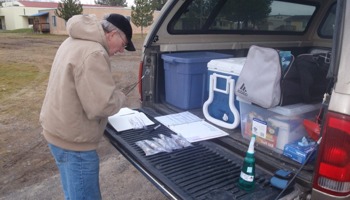
Sampling small mammals
For this project, EAS also maintained a hazardous chemical inventory and processed samples containing chemical and biological hazards. EAS performed more than 1,000 sample collection events and 5,000 labor hours on this project without any significant sample quality issues or safety incidents.
